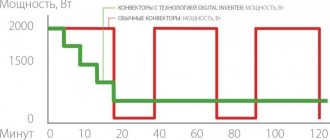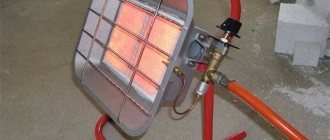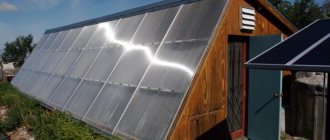A gas heater for a greenhouse will provide the seedlings with the necessary heat, allowing you to start heating as soon as necessary. It gained popularity due to its portability and relative cheapness, thanks to which even the seasonal use of a personal plot does not become a significant shock to the family budget. In order to fully enjoy the benefits of a gas heating system, you should study all the technical nuances of structures of this kind.
How to make gas heating for a greenhouse
Only a properly selected gas heater will cope with the task. The first classification system is based on the use of a water or gas-air heating unit. In the second case, warm air moves in special air ducts. Another classification system is based on the number of built-in heat sources.
For small greenhouses, a 1-phase is suitable, and for larger ones, a multi-phase greenhouse heater is suitable. If we talk about the advantages of both options, then it is preferable to choose the second one.
This is explained as follows:
- Small heat sources are installed along the entire perimeter of the building, which promotes uniform heating;
- If the region experiences sudden cold snaps, then the multiphase version of the heater is supplemented with a catalyst system;
- An IR heater will help smooth out high humidity and a high difference between night and day temperatures.
The retail chain offers a large selection of gas heating devices for use in greenhouses. When choosing, you need to take into account the operating temperature range, humidity level, building area, and so on. The more accurately the calculation is carried out, the less wasteful expenses the gardener expects.
Conclusion
Thus, heating a private greenhouse with a gas gun is not the only scenario when using this type of fuel. A competent approach to the formation of a scheme, taking into account all kinds of factors, attention to modern devices - all this will help to establish a system that will not have any weaknesses. Taking into account the fact that gas in Russia is significantly cheaper than electricity or solid fuel, a well-equipped scheme can pay for itself in just a couple of seasons.
Tips for beginning gardeners: how to install gas into a greenhouse
Lucky are those whose greenhouse is located in close proximity to their home. In this case, you can heat the seedlings with gas with minimal time and effort. The situation is more complicated when it is impossible to install a gas pipeline to the greenhouse.

Mobile sources of gas - cylinders - will help to get out of this situation. Our review will help you choose a gas heater: https://homeli.ru/stroitelstvo-doma/inzhenernye-sistemy/otoplenie/gazovye-obogrevateli. When using them, you must always monitor the concentration of carbon dioxide in the greenhouse.
If there is too much of it or vice versa, the seedlings will not grow. You can assemble the simplest gas circuit as follows. First, you need to decide whether gas will be supplied to the house and greenhouse, or whether you plan to heat only the seedlings.
In the second case, the heat supply diagram looks like this:
- Gas sources;
- Heat exchanger;
- Fan;
- Air duct for constant exchange of hot and cold air masses;
- Buffer – equalizing pressure;
- Exhaust gas outlet source.
Depending on the distance of the house from the greenhouse, the gardener chooses one of two methods of supplying a heat source. In the first case, we are talking about direct connection by pipeline, and in the second, about the use of gas cylinders. In order for heating to be as efficient as possible, gas heating is supplied with the obligatory presence of a reverse circuit. Its presence does not allow carbon dioxide to accumulate inside the greenhouse, and also reduces the likelihood of an emergency situation.
Basic Rules
In greenhouses with a large area, it is necessary to connect to a common gas pipeline network; small greenhouses can be heated with gas cylinders.
To heat a room with gas, you can use various heating equipment: gas burners or air heaters. Each of them has its own characteristics. Using burners is more dangerous. However, provided that there are no wooden elements in the greenhouse structure, you can resort to burners. In this case, the burners simply need to be connected to cylinders and placed throughout the entire area of the room requiring heating. Installing a heating system requires a lot of expense and effort, but this option will prove to be more convenient to use in the future.
Particular attention must be paid to the uniform distribution of heat in the room, as this represents the greatest difficulty when organizing gas heating. To do this, you need to connect a sufficient number of burners to the gas cylinder, which will be distributed evenly throughout the room. At the same time, providing gas heating to a greenhouse requires compliance with certain safety measures. For example, access to gas burners should not be hampered in any way. If any problems occur in their operation, it should be possible to turn them off immediately. In addition, gas equipment requires constant preventive maintenance.
Heating using gas requires an efficient ventilation system. A hood may need to be installed. This is due to the fact that gas heating leads to a lack of oxygen over time.
The advantage of air heaters is that they are able to provide a sufficient amount of heat and at the same time mix the heated air. Their only drawback is their high cost. First of all, costs will be required for the installation of polyethylene perforated pipes, which should form an entire system. In addition, it is necessary to install a chimney that will ensure the removal of combustion products from the room.
Universal gas gun for heating a greenhouse
The installation of a full-fledged gas-based heat supply system is not always justified. For example, seasonal greenhouses in temperate regions can be managed with the help of mobile portable devices.
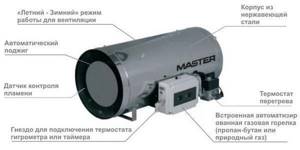
Depending on the manufacturer, a heat gun has a power from 4.2 to 10 kW. When choosing a specific model, it is necessary to take into account the area of the building, otherwise increased consumption cannot be avoided. Read tips on choosing a heat gun in the material:
From an economic point of view, a heating system based on such guns is justified only in one case. If the device is used at least 10-15 times during the season, the purchase makes sense. The average gun has the following characteristics :
- Average gas consumption: 310-410 g/hour;
- Thermal energy generation: 33 – 50 kWh/m3;
- Heated area: 25 – 65 sq. m.;
- Working volume range: 10 – 25 l;
- Working pressure: 29-35 mbar.
The use of gas guns allows you to specifically heat a certain area of the greenhouse. Before you start using the device, it would be a good idea to study its technical characteristics. Increased attention is paid to fuel consumption and thermal coverage. Based on the study of the mentioned characteristics, a model is selected that allows economical heating of the greenhouse.
#Heating #greenhouses with your own hands.
Reviews:
Evgeniy Belovol
writes: A brick kiln would work better, heat up slowly, but also cool down slowly.
Vladimir S
writes: Can you make a hog out of tin? Made from regular galvanized steel?
Irina Banakh
writes: Tell me, will 4 Buleryans of type 5 heat the greenhouse, the greenhouse is 70 m long and 20 m wide, the height in the middle is 3 m, and on the sides 2 m. Give an answer. Thank you
Some kind of game
writes: Tell me, what kind of pipe is this? I can't find a wide diameter anywhere.
Evgeniy Ataman
writes: what is the size of your greenhouse and how much kg per sqm do you get on average!? I’ve been wanting to start growing cucumbers for a long time... Thank you
Additionally, a so-called solar battery is installed around it. To do this, dig a trench 40 cm deep and 30 cm wide. After this, a thermal insulator (usually polystyrene foam) is placed on the bottom, covered with large sand, and covered with plastic film and earth on top.
Rationalization ideas: how to heat a greenhouse without gas and electricity
Continuing the topic of saving, it is necessary to dwell on one more point. In some cases, heating can be carried out from natural heat sources. At the same time, electricity, water and gas are completely abandoned. One such example is the use of solar energy. At first glance it may seem that this is not entirely economical, but the secret of success lies in proper preparation.
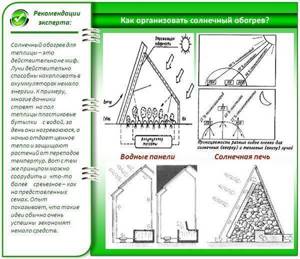
Read more about alternative energy sources at the link:
The following recommendations will help you avoid common mistakes during the installation of solar panels:
- The panels are installed on the sunny side. Slopes are installed on the opposite side of the greenhouse. They play the role of a vehicle that transfers and dissipates heat so that heated seedlings do not experience temperature shock.
- An excess heat accumulator is built under the structure. Here it is important to emphasize that it is better to do the installation before the actual installation of the greenhouse.
- Air heating from a natural source reduces the economic component of the project. It must be remembered that it can only be used in certain months, depending on climatic conditions.
Some features
When heating a greenhouse with gas, oxygen burns out and burns out, which is dangerous for plants, so ventilation/air supply systems must also operate simultaneously with gas heating.
Heating a greenhouse with gas means turning to specialists for help. Do not neglect this, as gas is a flammable and explosive substance. Failure to take the necessary safety precautions can pose a threat to your health and even your life. If you contact a specialist in this matter, he will help you determine the optimal number of burners or heaters that will provide heating for a greenhouse of a certain size for growing certain crops.
So, the undeniable advantages that heating a greenhouse with gas have:
- efficiency;
- efficiency;
- safety (subject to professional installation by a specialist in this field, who will give recommendations on the safe operation of heating devices).
Thus, you know the basic principles of arranging a heating system using gas. Compared to other methods of heating a room for growing plants, the use of gas has significant advantages. Most gardeners prefer it. However, the heat obtained in this way may not be enough if you need to heat a large greenhouse throughout the year.
In order for the plants in the greenhouse to bear fruit all year round, it needs to be equipped with a heating system. One such method is gasification. How feasible is this approach to heating a greenhouse space and how the system itself can be designed, read below.

